
Winepisser Worst Wine 2017 Smells Like Shit, Literally
 For the past two years, Winepisser has reveled in its negative reviews of wines — hell, snark is in our site’s name — but we hadn’t given the really terrible wines their due at the end of the year, during award season. This year we launch a new tradition: the annual Winepisser Worst Wine Award.
For the past two years, Winepisser has reveled in its negative reviews of wines — hell, snark is in our site’s name — but we hadn’t given the really terrible wines their due at the end of the year, during award season. This year we launch a new tradition: the annual Winepisser Worst Wine Award.
For 2017, I’m happy to announce — and I mean that, I am happy to, since this wine totally deserves all the bile and revulsion one can muster — that the 2017 Winepisser Worst Wine Award goes to Franclin Delgado Castilla Cavas de Caral 2015 from Peru.
First of all, it’s no confidence builder when you can’t be sure the label on the wine is even spelled right. The 2015 bottle I had was — or at least I could swear from memory it was — spelled “Franclin Delgado.” But no search results come up for it, spelled that way. Instead, import records from Peruvian searches show something called Flanklin Delgado, and others still Franklin. So who knows what the hell it’s called, but we do know the war criminals who make this stuff have a Facebook page, anyway.
You know you have a horrible wine if everyone at the wedding where it’s served chooses to remain totally sober, rather than touch the stuff. That’s where I encountered this filth-laden basura, at a wedding in downtown Lima. When I smelled it, I thought someone had just rubbed the glass in horse shit. I checked… that smell was coming from the bottle, not the glass. I looked around: sure enough, people were scrunching their noses, and entire bottles of the stuff sat untouched … for the entire evening! A friend of mine, a Peruvian attorney and wine snob, drank it, but it was his sister’s wedding and I suspect he didn’t want to insult the bride’s father for apparently buying wine from a horse stable, rather than a liquor store.
I am not kidding. The reek of this wine was a combination of gasoline and horse shit. It was the only wine that ranked a 0.5 in my reviews all year, and possibly the only one that got ranked that low… ever.
It’s not a surprise this comes from Peru, mind you. Peru just doesn’t seem to get it; they have a few limited areas with promising terroir, but the people here seem to be utterly clueless on winemaking, and the citizenry are just not wine-aware enough to care. The level of average wine knowledge in Peru goes like this: “sweet wines are for women, dry wines are for men.” And then the men drink all the sweet wine anyway. And, by the way, Boone’s Farm is sold as a “dry import” here in Peru.
Peru isn’t all horrible, though, and shows some promise. A chenin blanc from Ica won five stars last year, and remains in my wine cooler as the standby white to serve for friends and family who may not be too fussy. I love the stuff, even though I do suspect it’s being bottled for Peru, and not necessarily grown here.
I’m not sure what it will take to bring Peru up to speed with even 2nd tier wine producing nations, and it’s frustrating since we have Chile, Argentina and Uruguay so close as neighbors. But for now, Peru is a producer of largely junk wines. The pisco’s good, at least.
Runners up for Worst Wine included the horrid Canyon Road Cabernet Sauvignon 2015, which I said was like “mule urine”; a Château Baulac Dodijos Sauternes 2012, which I said tasted like your dad’s old photochemicals; Bodegas Santa Ana Caracter Shiraz-Malbec 2016, which tasted like “acid mixed with carcass”; and Apothic White, which I said tasted like “artificial banana cream cakes they sell in all night gas stations, but liquefied and then poured directly into your mouth.” That last one was ironic since Apothic Red won 2015’s Winepisser Best Wine Award; it was a short year. Those runners-up all netted a full star, at least, whereas the Cavas de Caral couldn’t even muster that.
If you want to pull the worst prank ever on someone, especially your wine snob pals, serve them Cavas de Caral. They may hate you — hell, they may murder you in your sleep! — but it would be worth it. It’s that terrible.
2017: NZ SB Led the Reviews, But Failed to Win 5-Stars
We’re heading into the final weeks of 2017, which means an announcement is quickly forthcoming for this years Winepisser Best Wine award. The contenders so far are a wild, rambling mix of whites and reds, dry and sweet, including — for the first time — an actual dessert wine. Here’s the list so far:
The Reds
- Pahlmeyer Proprietary Red – Napa – 2014
- Pittacum La Prohibición – Spain – 2012
- Joh. Jos. Prüm Graacher Hehimmelreich Spätlese – Germany – 2012
- Walla Walla Vintners Cuvée Red Blend – Washington – 2013
- Protos Ribera del Duero Roble – Spain – 2015
- Navarro Correas Structura Ultra – Argentina – 2010
The Whites
- Hugel Gentil – France – 2015
- Alvear’s Pedro Pedro Ximénez de Añada – Spain – 2014
- Dr. Loosen Riesling Beerenauslese – Germany – 2013
- Hestia Cellars Riesling Yakima Valley – Washington – 2013
- Hugel Alsace Cuvée les Amours Pinot Blanc – France – 2014
There’s still time for a last-minute entry, but the only wines in the tasting pipeline between now and decision time are a few low-end whites and the same Narbona Tannat that won last year. At least one event is coming up in the final days of December, which may see us getting a chance to buy some more exotic bottles, but that may get pushed into 2018.
What’s unusual, to me at least, is that not a single Marlborough Sauvignon Blanc made the top list, despite a tremendous showing. 29 of the 150 wines reviewed for 2017 were Sauvignon Blanc, with 18 of those from New Zealand. The average score of the essbies, however, ran only at about 3.25, which is surprising since it’s a wine I enjoy so much, that overall average was reduced by the non-NZ offerings, though, as the average for the NZ SBs was almost 4.0. I was sure that at least one would hit the 5-star mark this year, and none did. I’m enjoying the wines, for sure, but they just couldn’t outshine the whites that did make it to the top.
Following on from SB, Riesling was the 2nd most-rated wine of 2017, comprising 15 wines. That’s not a surprise, since I am a reesfan with no shame, even if I think it takes a back seat to its far more colorful cousin, Gewurztraminer. Of that grape, two made the 5-star list: a Dr. Loosen from Germany, and a fantastic reez from Hestia Cellars in Washington State.
The red blends took third most-rated wine, and a number of those won the coveted cincoestrellas, as shown in the list above. Meanwhile, Chardonnay, a grape I find typically resting somewhere between dull and loathsome, is climbing the list, and I suspect may get more play in 2018 as I explore less of the over-oaked California offerings and go back to the Old World to check its roots. I’m also expecting great things from Chenin Blanc, which may well surpass my Sauvignon Blanc obsession.
I am excited a dessert wine made the list, a Pedro Ximénez from Spain. This was a shockingly sweet wine, too, which usually turns me off, even for dessert wines, but wow! — this was a knockout. How they managed to get that much sugar in the wine without destroying it utterly is just amazing.
In previous years, it was clear the reds were likely to win the Best Wine Award, but this year I’d have to say it’s 50-50 between the reds and whites.
Hugel Becomes First Winery to Win Two 5-Star Reviews in One Year
Meet Hugel Gentil 2015, a Gewurztraminer blend from France’s Alsace region. My very first Winepisser post praised Hugel, a winery I have been familiar with for nearly 15 years, and which will likely be my favorite winery of all time when I shuffle this mortal coil. I’ve also had many bottles of Gentil and nearly every other offering from Hugel et Fils, so I’m no stranger, but it’s consistently fantastic quality always surprises me, in the best ways possible.
The is a blend of Gewurztraminer, Muscat Blanc, Pinot Gris, Riesling and (according to Vivino, anyway) Pinot Blanc and Sylvaner. Most of Hugel’s offerings are pure varietal, but this blend shows just what a good winery can do when they put their best grapes together. Essentially, it comes off as a gwertz/pinot gris blend, and all the others are hidden behind these two dominant flavors, but it’s — as I said — consistently fantastic.
Hugel et Fils is now the first wine producer to land two 5-star reviews in one year, but that’s hardly surprising, given the amount of the stuff I drink. Ultimately, however, it’s unlikely Hugel will win a Best Wine award from my site, because I am so familiar with their product. Winepisser is, at its heart, a wine exploration site, and it doesn’t do anyone much good to simply keep heaping praise on a single favorite winery from years past. It should just go without saying that I love Hugel, and their wines must be experienced whenever you get the chance.
See also my review for Hugel Alsace Cuvée les Amours Pinot Blanc 2014 here.
![]()
![]()
![]()
![]()
![]()
An Ode To Cork
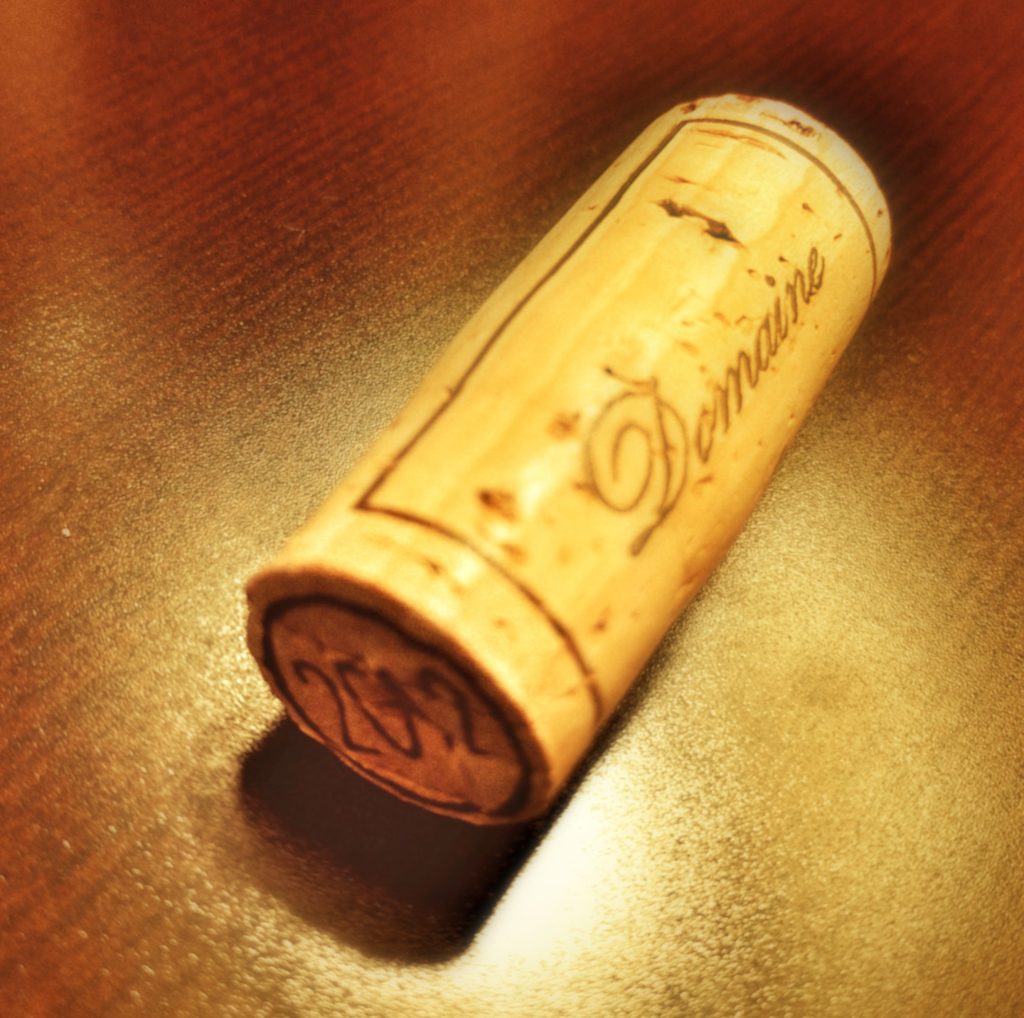 I get it. Cork rots. It leaks air. It’s unreliable. It makes no sense from a simple manufacturing standpoint.
I get it. Cork rots. It leaks air. It’s unreliable. It makes no sense from a simple manufacturing standpoint.
I mean, I really get it. In my day job, I’m an aerospace quality consultant, having worked with companies such as Lufthansa, Northrup Grumman, NASA and more. Reliability is a must in such industries; failure is not an option. Any manufacturer in this field that tolerates a 10% failure rate is insane. Even if the latest numbers, putting TCA taint at less than 4%, are accurate, that wouldn’t be allowed in any other industry.
But when it comes to wine, I want to put aside my experience in quality management. I don’t want to be burdened by concepts like “mean time between failures” or “first pass yield.” For me, wine is magical, it’s a near religious experience, it’s a cultural art that — in my fantasy, anyway — ascends beyond mere manufacturing process controls.
Of course that’s insane. Wine is a product like any other, made for consumption by consumers who pay for the product, and put profits into the accounts of the manufacturers. It’s a business. I know this, because it’s my profession. But dammit, allow me my escape! Just for a few hours!
Screwcaps ruin the experience for me. There, I said it. I’m a cork snob, I suppose. But for me, the act of opening the bottle is as much of an enjoyment as tasting what’s inside (well, close, at least.) It’s a ritual, and humans love rituals. I try to use my favorite openers (one of two, a bulky metal one I throw in my luggage when I’m traveling, and an ornate wood handle two-stepper that I use at home.) I enjoy the steps involved: scribe the foil, peel it away, position the screw just so, screw down, find that right lip contact and then pull. For me it’s as if I’m a priest in an ages-old temple ritual, communicating with my gods in the only way I know how: physical motions committed to memory, and performed with respect and slow certainty. There’s anticipation, too: you can’t know if that cork has a flaw that will make the entire thing a challenge, or if the bottle will just yield without a fuss.
And there’s an audience, of course. People like to watch the act of someone opening a wine bottle. They don’t like watching someone screw off a metal soda top; it’s boring. Cork invites the exotic. I love that.
I’m going to say something that’s true, something that many will understand, but which probably nonetheless reveals me as an amateur: I take cork into account when buying. If I have the choice between two wines of equal possibility and price, I would likely choose the cork wine over the screwtop. I know that in addition to the wine, I’ll have the experience of opening it. It’s like asking a fine cigar aficionado if he wants to buy a wrapped Montecristo, or if he’d prefer a pre-lit one. I’m not a cigar smoker, but I know they appreciate the ritual of cutting and lighting. It’s near sacrilege to suggest otherwise.
Then there’s the idea of material keepsakes: you can keep a cork. Often they have their own artistic qualities and markings. You can display them. You can roll a cork around in your hand, and recall fond memories of the wine itself, when it was tasted, the experiences you had. It’s like an old photograph. You can’t do that with a screwtop; it’s simply not the same. A collection of screwcaps looks like you’re a trash horder.
I’m given hope that cork may make a comeback, as the industry adopts aerospace-level quality controls — heck, I’ll offer up a discount on my consulting services to any cork manufacturer to prove my position! — so that we can return fully to cork without the spoilage or taint problems. I know in my heart that this can be achieved, and I refuse to apologize for my kneejerk rejection of screwcaps. I know the logic… I get it. But my ritualistic love of wine won’t accept anything else.
Let’s Look At The Worst Wines of 2017 (So Far)
Generally, 2017 started off pretty terribly, with not a single wine winning 5 stars until March, when Joh. Jos. Prüm’s 2012 Graacher Hehimmelreich Spätlese earned a cinco, and even that was easy, since I’m a fan of the German reezies. And then it wasn’t until another three months passed before the Pittacum La Prohibición 2012 and Hugel Alsace Cuvée les Amours Pinot Blanc 2014 landed 5 stars each. Another few months passed and finally in September, things started to take off, with a sudden rush of 5-star winners getting recognition. For a while there I thought 2017 was going to be a bad year, but now it’s turning into a real joyful experience.
But there have been some absolute dogs, and we should take a break to celebrate those wines who don’t ever, ever deserve to be celebrated. Each of these received two stars or (gag) less.
First up is Unparalleled – Sauvignon Blanc – New Zealand – 2016, which I said lacked “minerals like a diamond mine made of marshmallows. Worst NZ SB I’ve tasted… ever.” Unparalled indeed, as in perpendicular? It earned two stars.
Next was the horrid Layer Cake Malbec from Argentina, which seems ubiquitous on restaurant menus of even higher-end joints. I said this one was “like the 50-Foot Woman bent down and squirted an unripe vineyard in your mouth.” Ouch. Two stars.
Lindeman’s Bin 99 Pinot Noir 2015 won two stars as “a glass of wine-flavored meh,” and the 2014 Frescobaldi Rèmole Toscana Cabernet Sauvignon / Sangiovese got the same rating, called “dull and disappointing [like] M. Night Shyamalan in wine form.”
Another 2-star winner (?) was the 2014 Terrazas de los Andes Altos del Plata Malbec from Argentina, which had “zero finish, like a bad date that ends early with someone who couldn’t care less what you think.”
Coming in at only 1 1/2 stars was the 2014 Campanile Pinot Grigio Friuli Grave from Italy: “bland and vacuous like a speech on education policy by a bored septuagenarian senator.” Joining it in the just-under-two-star rating was the Loveblock Sauvignon Blanc from NZ (2016), which I said tasted like a cheap pinot grigio.
At the 1-star and under crowd — and yes, one of them won less than a full star — we have the bottom of the barrel, assuming these were actually put in barrels and not just stored in the bladders of sick goats. The 2012 sauternes from Château Baulac Dodijos Sauternes was so bad, I compared it to Polaroid chemicals, granting it a single full star.
Apothic White (2016) got a single star and, back in June, it looked like it might be the “worst wine of 2017.” I wrote that it tasted like those “artificial banana cream cakes they sell in all night gas stations, but liquefied and then poured directly into your mouth.”
Alas, another contender for worst wine has since crept up, and naturally it’s from Peru, which — like the national futbol team — just can’t seem to catch a break (although that 2015 Chenin Blanc from Ica did win five stars last year.) The horrid 2015 Franclin Delgado Castilla Cavas de Caral got only a half star after it was served at a wedding, and the entire table — in fact, every table, was seen avoiding the stuff. Imagine a wedding where the wine was so bad, people opted to stay sober… that’s how bad it was. I wrote, “literally smells like a gasoline tank flooded a horse stable.” There was — and I mean quite literally — a reek of horse shit coming from the wine. I mean, how do you get your wine to smell like horse shit? Seriously, I’m asking.
I can’t imagine a wine being more horrible than the Delgado, but who knows? There are still a few more months left to 2017, and I might yet encounter something deserving zero stars, a rating I’ve never once had to use.
The Label Doesn’t Lie: Argentina’s Structura Wins 5 Stars
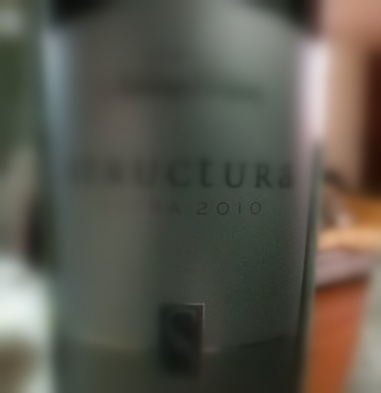 Red blends are really amazing these days, as winemaking becomes more technologically savvy and producers have better predictive abilities of what may result from a little mixing and matching. This fantastic blend of 54% Malbec, 40% Cabernet Sauvignon and 6% Petite Verdot is a great example. Meet Navarro Correas Structura Ultra 2010 from Tunuyán Argentina, a red blend that just works on all levels.
Red blends are really amazing these days, as winemaking becomes more technologically savvy and producers have better predictive abilities of what may result from a little mixing and matching. This fantastic blend of 54% Malbec, 40% Cabernet Sauvignon and 6% Petite Verdot is a great example. Meet Navarro Correas Structura Ultra 2010 from Tunuyán Argentina, a red blend that just works on all levels.
After spending 18 moons in new French oak barrels, this one is smooth and luxurious, but without the usual tropes of a “big fat red.” Potent but not aggressive, this shows notes of mint and earl grey tea, all swirling around a base of firm black cherry. Drinks remarkably well alone, and will pair with nearly anything you can think of; we had it alongside quinoa guisada. Would pair equally well with steak or chocolate cake. Tannins are soft and lovely but not at all shy.
If you’re keeping track of this years Best Wine contenders, and want to see who this Argentinian blend is facing, here’s an updated list. It’s an eclectic mix of reds, whites and dessert wines.
- Pahlmeyer Proprietary Red Blend – Napa – 2014
- Pittacum La Prohibición – 2012
- Joh. Jos. Prüm’s Graacher Hehimmelreich Spätlese – 2012
- Hugel Alsace Cuvée les Amours Pinot Blanc – 2014
- Walla Walla Vintners Cuvée Red Blend – 2013
- Hestia Cellars Riesling Yakima Valley WA – 2013
- Dr. Loosen Riesling Beerenauslese – Germany – 2013
- Protos Ribera del Duero Roble – 2015
- Alvear’s Pedro Pedro Ximénez de Añada – 2014
For more about the Structura, visit the winery’s website here.
![]()
![]()
![]()
![]()
![]()
Dessert Wine or Wine Dessert: 5-Star Pedro Ximenez from Alvear
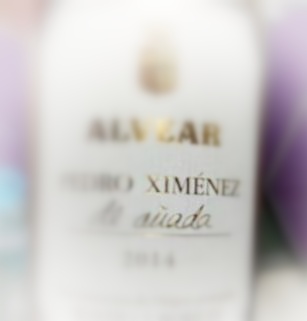 Normally we hold the word “syrupy” as a pejorative, hinting at cough medicine or sickeningly sugary prison wine. I’m a fan of dessert wine, and at the same time have encountered my fair share of syrupy garbage that is sold as such, so I’m tuned into when a sweet wine hits the mark, and when it doesn’t.
Normally we hold the word “syrupy” as a pejorative, hinting at cough medicine or sickeningly sugary prison wine. I’m a fan of dessert wine, and at the same time have encountered my fair share of syrupy garbage that is sold as such, so I’m tuned into when a sweet wine hits the mark, and when it doesn’t.
Meet Alvear’s Pedro Ximénez de Añada 2014, a delicious wine that I can say defies the pejorative, and wears its syrupy nature with pride. This is thick and viscous, clinging to the bottle as if it doesn’t want to fall into your glass, the tease. The nose telegraphs everything the palate will experience: flowers, plums and figs. No raisins here, like so many other dessert wines, this comes off as more sophisticated and mature, but nevertheless is shockingly sweet. How Alvear managed to pump so much sugar into a wine and keep it from becoming cloying, I don’t know. It’s smooth and rich, and at 17% alcohol, a powerful sweet treat.
I can’t recommend pairing this with a dessert as the wine should be served as the dessert. I told that to a table of friends, and they thought I was insane, as they looked around for their after-dinner cake or chocolate. After they had a tiny glass or two, they were utterly satisfied, and not a single piece of cake was served.
The potent alcohol content means you serve this in aperitif glasses, and despite the bottle being undersized, this will likely last a while. Having said that, only days after our tasting party, I was approached by a number of people who asked if I had more bottles of this Alvear to share; it was a huge hit.
Visit the Alvear website here.
![]()
![]()
![]()
![]()
![]()
Protos Beats Out Argentinian Competitor with 5-Star Tempranillo
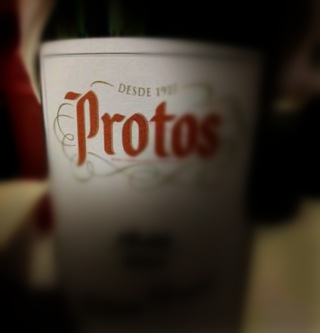 We placed this into a mano a mano battle versus Argentina’s Zuccardi Q 2012 offering, and it was a close match. Eventually, however, this Protos Ribera del Duero Roble 2015 won out, largely on the basis of is perfect tannin balance and playfully misleading nose.
We placed this into a mano a mano battle versus Argentina’s Zuccardi Q 2012 offering, and it was a close match. Eventually, however, this Protos Ribera del Duero Roble 2015 won out, largely on the basis of is perfect tannin balance and playfully misleading nose.
In the glass, the color is dark purple, a hue that car manufacturers wish they could mimic. On the nose it’s sweet black cherry and chocolate, but it’s a clever ruse: that sweetness doesn’t show up as jammy sugar on the palate. The tannins are smooth without being so lush as to become blanketed over, and the robust flavor in play here is a unique cherry, with a hint of cellar must.
This was tried over a two day period, tasted multiple times against the Zuccardi Q, both by itself and paired with various plates. The Zuccardi Q did well, but the Protos just enhanced anything that it was paired with, from Peruvian lomo saltado to spicy chicken. We even handed this off to some non-wine lovers, and they thought it was a winner.
Highly recommended.
More information from Protos here.
![]()
![]()
![]()
![]()
![]()
Dr. Loosen Riesling Beerenauslese – Germany – 2013
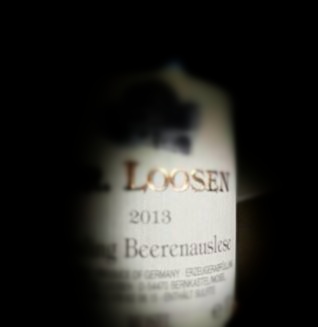 Dr. Loosen won a five-star review for its 2014 Kabinett Riesling last year, and got praise for other selections, including it’s reliably great Blue Slate offering, which I’m drinking as I write this. But this Beerenauslese dessert reez earns the good doctor yet another 5-star award.
Dr. Loosen won a five-star review for its 2014 Kabinett Riesling last year, and got praise for other selections, including it’s reliably great Blue Slate offering, which I’m drinking as I write this. But this Beerenauslese dessert reez earns the good doctor yet another 5-star award.
The nose is a complicated mix of the usual sweet fruits and some unusual, but exciting, herbs… is that patchouli? On the palate it’s just as interesting, as there’s no raisin or fig here, but instead plums and the slightest hint of blueberries. Not particularly viscous, and with a remarkably low alcohol content of 6.5. Can be sipped by itself or with a light dessert, such as white cake or perhaps tiramisu before the cappuccino.
Just insanely good!
You can learn more about Dr Loosen here.
![]()
![]()
![]()
![]()
![]()
Winepisser Stumbles Through Columbia Valley Washington
 My aerospace travels took me, of all places, to Redmond WA, literally pissing distance from the godawful Chateau Ste. Michelle winery where, if there weren’t so many damned cameras around these days, I probably would have literally pissed on the building. And the wine might have tasted better as a result.
My aerospace travels took me, of all places, to Redmond WA, literally pissing distance from the godawful Chateau Ste. Michelle winery where, if there weren’t so many damned cameras around these days, I probably would have literally pissed on the building. And the wine might have tasted better as a result.
Thanks to Hurricane Harvey, I was trapped in the region, since my flight out of Seattle was intended to layover in Houston. United Airlines — yeah, the one that drags doctors off planes and then fills them full of scorpions (the planes, not the doctors, but anything’s possible), thinks it’s a good idea to intentional route traffic into a major national disaster zone. Since I didn’t want to become United’s next headline, I opted to sit tight in the Seattle area and wait for flights that didn’t put me in the middle of the worst human disaster in recent history. That gave me a few extra days to stumble aimlessly through the area, check out the gorgeous wineries, evergreen trees and misty hills, while sampling some local vintages.
I was struck at an odd contradiction: while, sure, there were plenty of wineries offering tours and tastings, the local restaurants — most of which marketed themselves literally using the words “hip” and “trendy” — nevertheless listed precious few Columbia Valley wines on their lists. Instead, the restaurants tended to offer a really great selection of wines from California, New Zealand, Argentina, Italy and France. Of course every single menu also had at least one Chateau Ste. Michelle bottle listed, but we’ve already discovered that is a menu printing issue, and not an actual endorsement by any living, breathing restaurant wine buyer. One old-style, authentic Italian joint I ate at was so hardcore authentic Italian, their wine list — which must have had at least 200 bottles offered — didn’t have a single wine from any country that didn’t look like a boot. Try finding this to be true in Napa.
So it wasn’t confidence inspiring, if even the local buyers are not pushing the local wineries. Also, many of the properties with signs announcing themselves as so-called “estate” wineries looked a lot like dubious wood-paneled houses from the 1970’s that probably have trampolines and cars on blocks in the back yard; it seems anyone with a few grapes on their property can call themselves a winery in this region. I’m betting a few of these so-called “estates” have bodies buried under their porches. Imagine one of those western highway pull-overs that sell dreamcatchers and pickled rabbit fetuses labeled “alien babies,” but without the dreamcatchers or pickled rabbit fetuses.
So I gave up on trying to find a decent winery to tour, partly due to my typical ennui about it all, and partly because the rental car company had given me an Infiniti and I was enjoying driving, not pulling over. Instead I found the better local wine shops, and got recommendations from the sellers there.
During the trip I tried to seek out an equal number of local Columbia Valley whites and reds, and — as you’ll see — was generally unimpressed. While the ones I tasted were generally better than the Ste. Michelle swill, they still weren’t up there with the products coming out of other regions. I was, however, surprised at the variety of offerings, and we did hit it lucky with one spectacular, five-star red, and an amazing five-star riesling, both of which I’ll save for last.
The Reds:
Charles & Charles Cabernet Blend
Weird but interesting nose, like an actress who considers surgery but probably shouldn’t. Powerful berry mixed with hints of menthol and peppermint and rich soil. On the palate it’s smooth due to low tannins and low acid, so didn’t hold up well with classic ribeye. Better to drink this solo.
![]()
![]()
![]()
Northstar Columbia Valley Merlot – 2012
Woody goodness in the shnozz but disappointing otherwise. Given the great reviews for this I was surprised and the blame must lie with the vintage. Paired with wagyu flatiron steak and chimichurri and the wine was utterly lost, but it should have stood out. By itself it’s nice, smooth, medium tannins and with slight fruit but not at all jammy. I recommend seeking a differ year as this one was disappointing.
![]()
![]()
![]()
Ross Andrew Glaze Cabernet Sauvignon – 2015
Middling cab, needs air or serve with aerator. Might get better with some years under its belt. Moderate tannins, moderate blackcurrant notes, moderate finish. As a result it seems overmoderated. I drank this solo but might liven up with a good food pairing. Maybe.
![]()
![]()
![]()
Fidélitas Optu Cabernet Sauvignon – Red Mountain WA – 2013
Dry cab, like a taxi that’s never been washed. Sting of leathery tannin bite masks any fruit here but it’s also not as meaty as, say, one of those tannats from Uruguay. Overall was not particularly pleasant, and I’m not convinced this will improve with age.
![]()
![]()
The Whites
For a Song Chardonnay – 2015
Surprisingly good chardonnay probably because it eschews typical shardy tropes. This is light on the oak but not at all on the opposite (steely) end of the spectrum. Little slices of apple and chamomile play together very nicely. Finish is a bit tart but not too much so. You won’t mistake this for a traditional chardonnay and that’s a good thing.
![]()
![]()
![]()
![]()
Tamarack Chardonnay – 2015
Readers of Winepisser.com know I am not a chardonnay fan and here’s an example of why: it’s boring. This shardy is the liquid equivalent of tilapia; it takes on whatever flavor you pair it with, but has no character of its own. I tasted a hint of pear and maybe some apple if I squinted my imagination. Otherwise nothing.
![]()
![]()
Poet’s Leap Riesling – 2015
Wow. Very unique reez, this has the smoothness of a chardonnay but is definitely riesling. Not much nose but what is there is floral. On the tongue it’s a flavorful hit of apples but not too tart. Not sure how they made this buy I blame magic. Worth seeking out.
![]()
![]()
![]()
![]()
The Winners
The Walla Walla area within the region is said to have the best wines, superior to those elsewhere in the Columbia Valley, and the prices seem to reflect this: labels with the “Walla Walla” name on them seemed to fetch a higher price. So perhaps it’s no surprise that one of the two 5-star wines of this outing bore the mark.
Walla Walla Vintners Cuvée Red Blend – 2013
Tremendous! Nose is potent with blueberries and spices and musk cologne and mossy earth. The you’re hit with a smooth, balanced-tannin experience of flavorful berries and a hint of cellar must. Paired with spicy lamb chops – seriously – and it enhances the plate, never wilting. Perfectly balanced. Highly recommended. Suggestion:serve cooler than you would an ordinary red.
Learn more here.
![]()
![]()
![]()
![]()
![]()
One the white side, a surprise late entry — literally on the last day of the trip — won five stars after it was served to us at trendy alt-burger joint Woodblock, a place I’d recommend since it was the only hipster joint where the food didn’t taste like cardboard. In fact, their menu is first class, the wine list pretty spectacular, and they didn’t play Van Halen while serving Mexican food like the awful Matador restaurant nearby.
Hestia Cellars Riesling Yakima Valley WA – 2013
Vivino says this wine comes from Oklahoma which apparently got annexed by the state of Washington where the Yakima Valley — part of the Columbia Valley — actually is. Seriously, look:
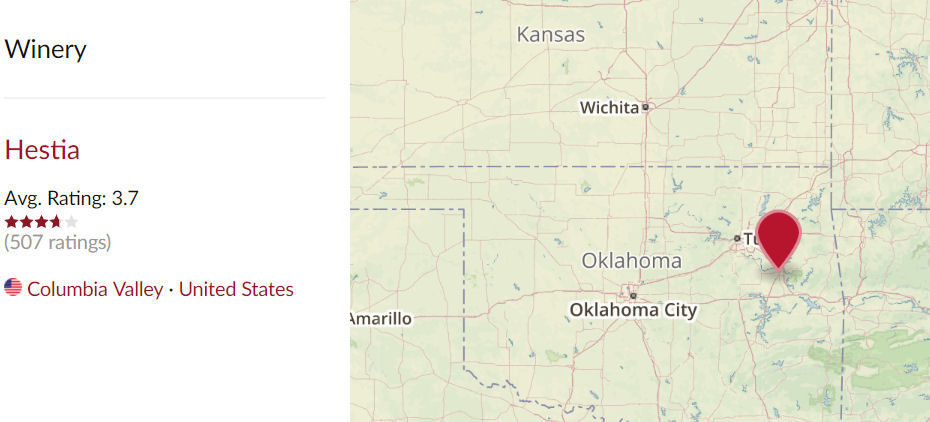
Geography’s hard when you’re drunk. I guess.
Middling reviews on Vivino surprised me because this is actually a fantastic riesling! Fruit and flowers on the nose and then it’s all rich pear and pink grapefruit and rainbows. This is not oversweet though, so don’t misread me;it’s just right, with enough sugar to keep it in the reez family but not enough to call it anything but slightly dry. Gorgeous fruit and perfume.
Check out the winery’s web page here.
![]()
![]()
![]()
![]()
![]()
Quick Cuttings